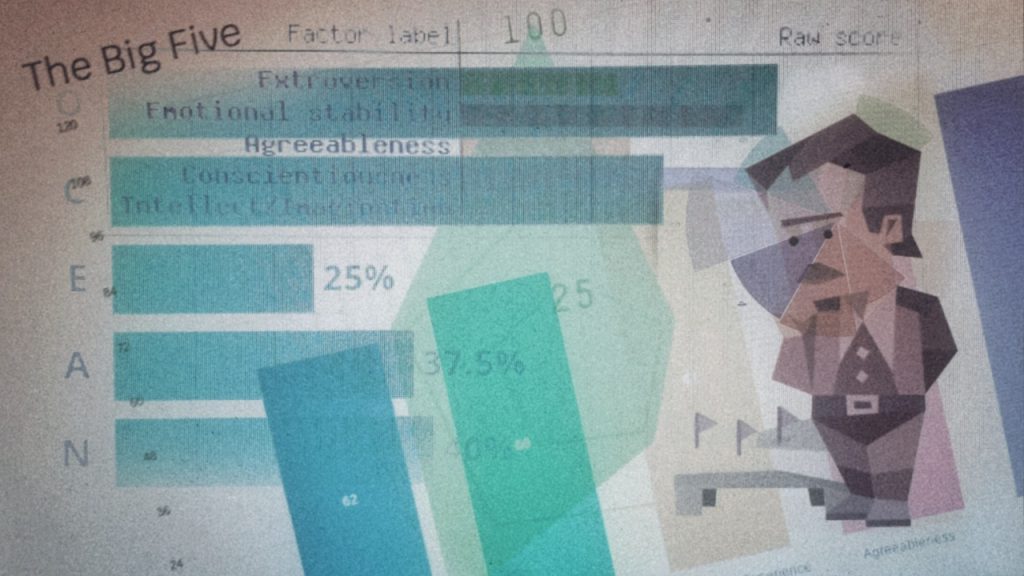Personality Psychology 101
I’ve recognized that a lot of tests and articles in mainstream media about personality psychology seem to not get it quite right. While it might be entertaining to figure out which personality “color” you are, or which fictional character you most resemble (I’m 82% Obi-Wan Kenobi (!)), the science behind these tests may unsurprisingly not be very robust. I don’t think that everything we do must be scientifically justified. If a personality test tells you that you’re like a Jedi Knight, and that makes you do awesome wizard things; go for it! But for those who want to dig deeper into personality psychology, you might just have arrived at the right place. I have studied personality psychology both inside and outside the classroom, but I’m by no means an authority on the subject. However, I can give a crash course in personality psychology, give my thoughts on the topic, and point you to some interesting sources – and that’s what this text is for.
The Big Five, also known as the Five-Factor Model (FFM), is indisputably the most scientifically valid model of personality. It emerged from the lexical hypothesis; that important individual differences in personality would naturally be manifested in our language. From extensive lexical research and testing traits, over decades, a select few central personality characteristics were extracted. Although there are various variations of the FFM, including more or fewer traits and sub-traits, the FFM is today the most widely used personality test and model of personality within the sphere of psychology. Perhaps you’ve heard of the acronym “OCEAN” for the traits in the FFM:
- O – Openness to Experience: The dimension of creativity, distinguishing artistically and/or intellectually inclined people from down-to-earth people.
- C – Conscientiousness: The dimension measuring dutifulness, discipline, goal orientation, and attitude towards order.
- E – Extraversion: The dimension concerned with sociability, excitability, talkativeness, and emotional expressiveness.
- A – Agreeableness: The dimension characterized by a person’s proclivity to be friendly and get along with other people.
- N – Neuroticism: The dimension reflecting a person’s sensitivity to negative emotions.
These traits serve as a filter of perception in which we view the world. If you’re high in agreeableness and extraversion you might see parties as a great opportunity to make friends, whilst someone very introverted may even perceive the situation as a threat, especially if you’re high in neuroticism as well. If you’re high in conscientiousness you might in a business setting be very bothered by late attendants and unfinished deadlines, while it might not be a big deal for the people on the other side of the spectrum; they probably happen to be the cause of this problem. If you’re high in openness to experience you probably see the value in visual art and abstract ideas, whilst a down-to-earth person will be more oriented towards concrete matters. These are differences influencing the way we perceive, interpret and experience stimuli. We’re more alike than we’re different, but we do differ in personality. After all, a category that can be applied to every entity loses its meaning.
A common question that arises when discussing personality is whether it can be changed or not. This is an understandable question, as there is probably at least one of the core traits that we wish we could score differently on. Personality psychologists seem to broadly define personality as “patterns of behavior and experience”. These patterns are generally stable across time – if you’re not measuring stable patterns, they have no predictive validity and are therefore not of much use. However, personality can be thought of as a hierarchy, meaning that the FFM traits can be broken down into sub-traits. For example; conscientiousness is both about orderliness and industriousness. While these are related, and while your preference for order seems to be more permanent, you can do quite a bit to set up habits and improve your ability to follow schedules (industriousness).
The Use of Personality Tests and Personality Psychology
Personality psychology has been so useful for me because I’ve increasingly been able to attribute behaviors and attitudes to the traits in the FFM, in a way that actually makes sense. It’s been useful to know the fundamental personality traits, and what characterizes them. Instead of using the more superficial descriptions, rather reflective of moods, I can abstract commonalities in how a person functions, and use them as a frame of reference for explaining and predicting their actions. It’s been useful to know general statistics, such as women scoring higher in agreeableness than men, and men being more extreme in their personality on a population level. The FFM traits, and data on how we as a population score on them, can be used for explaining social phenomena, such as why it’s disproportionately men who occupy both high levels of positions and prison cells. It’s been useful to know that we think differently because of our personalities. When I realized that a person’s political orientation may largely be a reflection of his or her personality (left-wing/liberals tend to be higher in openness and lower in conscientiousness, while the reverse applies for right-wing/conservative), I mostly stopped the little involvement I had in party politics and instead focused on the question of how an understanding of the human mind can be used to make politics more productive and less destructive.
Perhaps the main use case for personality psychology for the individual is so that you can tailor your life in a way that your internal temperament (personality) matches the external demands. Personality can be thought of as natural inclinations, heavily determined by our genetics and experiences in childhood. I don’t think that changing one’s personality is a helpful way to look at improving one’s character. It can be good to know your natural temperamental inclinations so that you can understand what you might struggle with and why, and identify the aspects you can capitalize on. For example, I know that socially demanding jobs wouldn’t fit me (low in extraversion), whereas creative (high in openness), yet structured (high in conscientiousness), endeavors are better suited for my temperament. I’ve had a feeling for this for a long time, but diving into the literature on personality psychology has helped me articulate what I abstractly knew, in a higher level of resolution.
I think it’s important to distinguish personality from skills; extraversion is about a person’s natural preferences towards social stimuli and doesn’t necessarily measure a person’s social skills. The preference is a more permanent part, while the competence can be changed. Another example is that if you’re low in conscientiousness it can be good to know that structure and routines might be something you intentionally have to work a lot on, in order for your natural lack of conscientiousness to not affect your life too much. If you’re aware of approximately where you score on this trait, it can help you to decide what to practice; you can’t really change natural proclivity, but you can improve your skillset. While the room of a person low in conscientiousness may not be very organized, it can be a good idea to work on setting rules about the level of chaos that should be acceptable before an intervention is necessary, in order to both respect this nature and also achieve more balance. Regardless of the given personality, we can always focus on developing mindsets and skills to support, or make up for, our set of personalities.
Navigate the world of personality tests
I have to give a point to the humanistic perspective in personality psychology, that for instance states that one shouldn’t feel unnecessarily limited by a scientific theoretical model. It’s not advisable for young children to take personality assessments, as this can define what they believe to be capable of, in a limiting way. It’s approximately in our 20s that our personalities become increasingly stable, and it’s also approximately in this age where I think we become increasingly good at utilizing personality assessments for productive use.
When I tried sorting out the best personality tests available for free on the internet, I came across an article (last source in Sources & Further Reading) that presented a list of 10 tests based on the FFM, most of them which I’d already successfully taken. I recommend taking multiple tests on the list, to get an overarching feeling of your personality. When I was going to test my IQ it wouldn’t be accurate to settle with the first test I came across, but I had to take multiple tests that seemed valid, to get an idea of what my IQ is. IQ tests and personality tests based on the FFM seem to have an unusually strong test-test reliability, meaning that the result of a test is representative and stable – so that if you take the same test months in the future, it will report a result significantly similar to the previous result. I’ve at this point taken all the tests in the article, some of them multiple times, across a long time span, and in my estimation the results are generally stable inside and between tests.
I should note that there are other personality tests besides those based on The Big Five. Corporations tend to use the much less scientifically valid Myers-Briggs Type Indicator (MBTI), probably on 16personalities.com, because it’s free, doesn’t require much effort, and it shouldn’t offend anyone. The problem with this test is that it’s standing on pseudoscientific grounds, with a lack of predictive validity regarding job performance. However, as I stated in the opening paragraph, I don’t at all think that we need science for everything we do. If a frame of reference helps you navigate the world by understanding people better, forging stronger relationships, and reaching a higher potential, does it matter if that frame of reference is unscientific? For example, I was invited by a friend of a friend of a friend to join his creative team, because he knew my results on the Myers-Briggs test (INTJ; introverted, intuitive, thinking, judging). He told me that his “extroverted intuition” said that we would make a good entrepreneurial duo, and he hasn’t been wrong so far. I also recently took a DISC assessment (dominant, influent, compliant, steady; personality) after skim reading Thomas Erikson’s well-known popular science book Surrounded by Idiots. I have to say that the test and the book made sense, and I can see how they can be useful in the public eye.
Finally, it’s not obvious how we want to score on these traits. For example; On the surface, it might feel like a good idea to be high in agreeableness and get along with people. However, having the capacity, and inclination, to be disagreeable is necessary for negotiating and getting what you want. Think about it; it’s the more disagreeable people who earn more money, and it’s the very agreeable people who would be in need of assertiveness training to prevent being taken advantage of. Being more agreeable is valid. Being more disagreeable is valid. It might be more suitable for disagreeable people to work in sales than to work with taking care of people, and vice versa. Another example is that being high in openness can be both a blessing and a curse; engaging in creative endeavors can open up the world for sublime experiences, but can also be a source of obsession, and a devastating one at that since creative production can be difficult to monetize. Being high in openness can be very valuable, while it’s also a good idea to have more practical people around. Problems may arise if a person scores on the extreme ends of these distributions; deviating significantly from the norm in a fundamental personality trait. It might be difficult to build a social network if you’re on the 4th percentile in agreeableness, or it might be difficult to work in a traditional job if you’re extremely low in conscientiousness, or extremely high in openness.
Conclusion
People are more similar than different, and we need the differences. We think differently because of our personalities, and it can therefore be useful to have a basic understanding of the main traits that make up our personality, in order to understand your own behavior and attitudes, as well as those of the “idiots” you’re surrounded by. I believe that with an understanding of how we work, and that the differences are here for a reason, we can improve the way we’re networked together: What if we played to our personality strengths in order to operate optimally in this network we’re entangled in? What if many people did that?
Sources & Further Reading
The sources marked with a single asterisk (*) have been important sources for learning about personality psychology. The same applies to sources marked with two asterisks (**), but these are also available for free and recommended by me for further investigation into the topic.
Caprara, G. V., Schwartz, S., Capanna, C., Vecchione, M., & Barbaranelli, C. (2006). Personality and politics: Values, traits, and political choice. Political psychology, 27(1), 1-28.
Cobb-Clark, D. A., & Schurer, S. (2012). The stability of big-five personality traits. Economics Letters, 115(1), 11-15.
*Costa Jr, P. T., & McCrae, R. R. (2008). The Revised Neo Personality Inventory (neo-pi-r). Sage Publications, Inc.
*DeYoung, C. G., Quilty, L. C., & Peterson, J. B. (2007). Between facets and domains: 10 aspects of the Big Five. Journal of personality and social psychology, 93(5), 880.
Erikson, T. (2019). Surrounded by Idiots: The Four Types of Human Behavior and how to Effectively Communicate with Each in Business (and in Life). St. Martin’s Essentials.
**Jordan B Peterson (2017, March 11). 2017 Personality 14: Introduction to Traits/Psychometrics/The Big 5 [Video] YouTube. https://youtu.be/pCceO_D4AlY
**McCrae, R. R., & Costa Jr, P. T. (2008). The five-factor theory of personality. (Available: https://www.researchgate.net/profile/Paul-Costa/publication/284978581_A_five-factor_theory_of_personality/links/5a159be94585153b546c8f72/A-five-factor-theory-of-personality.pdf)
**Spielman, R. M., Jenkins, W., Dumper, K., Lovett, M., & Perlmutter, M. (2019). Psychology (OpenStax). (Available: https://openstax.org/details/psychology)
Weisberg, Y. J., DeYoung, C. G., & Hirsh, J. B. (2011). Gender differences in personality across the ten aspects of the Big Five. Frontiers in psychology, 2, 178.
Wong, K. (2021, May 6). Top 10 Big Five Personality Tests (With Free Options). The Millennial Grind https://millennial-grind.com/top-10-big-five-personality-tests/



